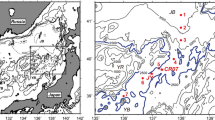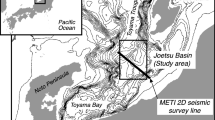Abstract
Bottom temperature variation (BTV) is a serious problem in determining the thermal gradient and heart flow of the sediments in shallow seas. The water depth of the East China Sea shelf is mostly below 150m, and the heat flow measurement is strongly affected by BTV. Following a statistical algorithm, we rechecked the temperature and thermal conductivity data of the cruises KX90-1 and KX91-1, carried out by a cooperation program of China and Japan, and calculate the heat flow in a site without long-term temperature record. The calculated heat flow in the site was 58.6±3.6 mW/m2, being just within the range of the drill heat flow value of East China Sea shelf. The inversed amplitude spectrum of BTV has a peak in frequency of 1/10 per year, and the annual component is also an important part. Comparison with two lakes of Lake Greifensee and Lac Leman (i.e. Lake Geneva), which are in different water depth, revealed that with increasing water depth, the peak of amplitude spectrum moved towards low frequency components. The heat flow values calculated in this paper and from petroleum bore hole in East China Sea shelf are much more close to that in southeast China than in Okinawa Trough.
Similar content being viewed by others
References
Beardmore, G. R. and J. P. Cull, 2001. Crustal Heat Flow: A Guide to Measurement and Modelling. Cambridge University Press, New York.
Finckh, P., 1981. Heat flow measurement in 17 perialpine lakes.Geol. Soc. Am. Bull. Part II.92: 452–514.
Hyndman, R. D., E. E. Davis and J. A. Wright, 1979. The measurement of marine geothermal heat flow by a multipenetration probe digital acoustic telemetry and in-situ thermal conductivity.Mar. Geophys. Res. 4(2): 181–205.
Kinoshita, M., S. Goto and M. Yamano, 1996. Estimations of thermal gradients and diffusivity by means of long-term measurements of sub-bottom temperatures at western Sagami Bay, Japan.Earth Planet. Sci. Lett. 141: 249–258.
Langseth, M. J., 1965. Techniques for measuring heat flow through the ocean floor.In: Lee, W. H. K. ed., Terrestrial Heat Flow. American Geophysical Union,Geophys. Monogr. Ser. 8: 245–271.
Li, N., 1994. Preliminary study on the method of heat flow measurement in shallow seas.Journal of Ocean University of Qingdao 24(2): 263–270. (in Chinese with English Abstract)
Li, N., 1995. Geothermics of the Okinawa Trough. Qingdao Press, Qingdao, China. (in Chinese)
Li, N., S. Zhao and P. Vasiliev, 2000. Geology of Marginal Seas in the Northwest Pacific. Education Press of Heilongjiang, Harbin, China. (in Chinese)
Matsubara, Y., H. Kinoshita, S. Uyeda and A. Thienprasert, 1982. Development of a new system for shallow sea heat flow measurement and its test application in the Gulf of Thailand.In: Gupta, M. L., ed., Terrestrial Heat Flow.Tectonophysics 83: 13–31.
Pollack, H. N., S. J. Hurter and J. R. Johnson, 1993. Heat flow from the earth interior: Analysis of the global data set.Rev. Geophys. 31: 267–280.
Tarantola, A. and B. Valette, 1982a. Generalized nonlinear inverse problems solved using the least square criterion.Rev. Geophys. Space Phys. 20(2): 219–232.
Tarantola, A. and B. Valette, 1982b. Inverse problems=Quest for information.J. Geophys. 50: 159–170.
Wang, J., 1996. Geothermics in China. Seismological Press, Beijing, China.
Wang, K. and A. E. Beck, 1987. Heat flow measurement in lacustrine or oceanic sediments without recording bottom temperature variations.J. Geophys. Res. 92(B12): 12837–12845.
Wang, K., P. Y. Shen and A. E. Beck, 1986. On the effect of thermal properties structure and water bottom temperature variations on temperature gradients in lake sediments.Can. J. Earth Sci. 23: 1257–1264.
Xu, W., R. Jiao, J. Le, D. Zhou et al., 1995. Study on the heat flow of East China Sea shelf.Proceeding of Geophysics 10(2): 32–38 (in Chinese with English Abstract)
Yu, P. and N. Li, 1992. Crustal Heat Flow of East China Sea. Ocean Press, Beijing, China. (in Chinese)
Author information
Authors and Affiliations
Corresponding author
Additional information
Supported by the National High Technology R&D Program of China (2004 AA616060)
Rights and permissions
About this article
Cite this article
Guanbao, L., Baohua, L. & Naisheng, L. A probe heat flow value of the East China Sea shelf. Chin. J. Ocean. Limnol. 24, 243–249 (2006). https://doi.org/10.1007/BF02842623
Received:
Accepted:
Issue Date:
DOI: https://doi.org/10.1007/BF02842623




